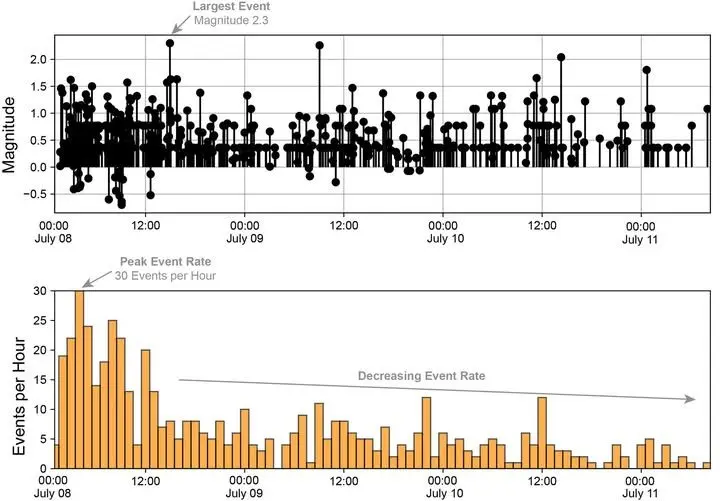MOUNT RAINIER, WA – A notable swarm of small earthquakes has been recorded beneath Mount Rainier since the early hours of July 8, marking the largest earthquake swarm ever detected at the volcano, according to the U.S. Geological Survey (USGS) Cascades Volcano Observatory.
The Pacific Northwest Seismic Network (PNSN) began detecting seismic activity at 1:29 a.m. PDT on July 8. As of 9 a.m. on July 11, more than 390 earthquakes have been located, with the strongest reaching a magnitude of 2.3. Most of the quakes occurred 1.5 to 4 miles beneath the summit. Although the frequency of events peaked on July 8, activity has since decreased and is continuing at a lower rate.

Plots of earthquake magnitudes (top) and numbers (bottom) over the course of the July 8-11 seismic swarm at Mount Rainier, Washington. The swarm was greatest in terms of numbers of events and their magnitudes during the morning of July 8. After that time, earthquake rates slowly decreased over the course of the following days.
Despite the volume of tremors, the USGS emphasized that the current activity remains within normal background levels for Mount Rainier. Earthquake swarms occur 1–2 times per year at the volcano, typically smaller in scale. The current alert level remains at GREEN/NORMAL, indicating no immediate threat.
Experts believe the swarm is likely caused by the movement of water within the crust and not indicative of an imminent eruption. No tremors have been felt on the surface, and no damage has been reported.
Mount Rainier’s last significant earthquake swarm occurred in 2009 and lasted three days. This week’s swarm has already surpassed that event in both number and energy.
The USGS continues to monitor the situation closely. For live updates and data, visit the Pacific Northwest Seismic Network at: https://pnsn.org/volcanoes/mount-rainier
Full details and ongoing updates can also be found at the USGS website:
🔗 https://www.usgs.gov/observatories/cvo/news





